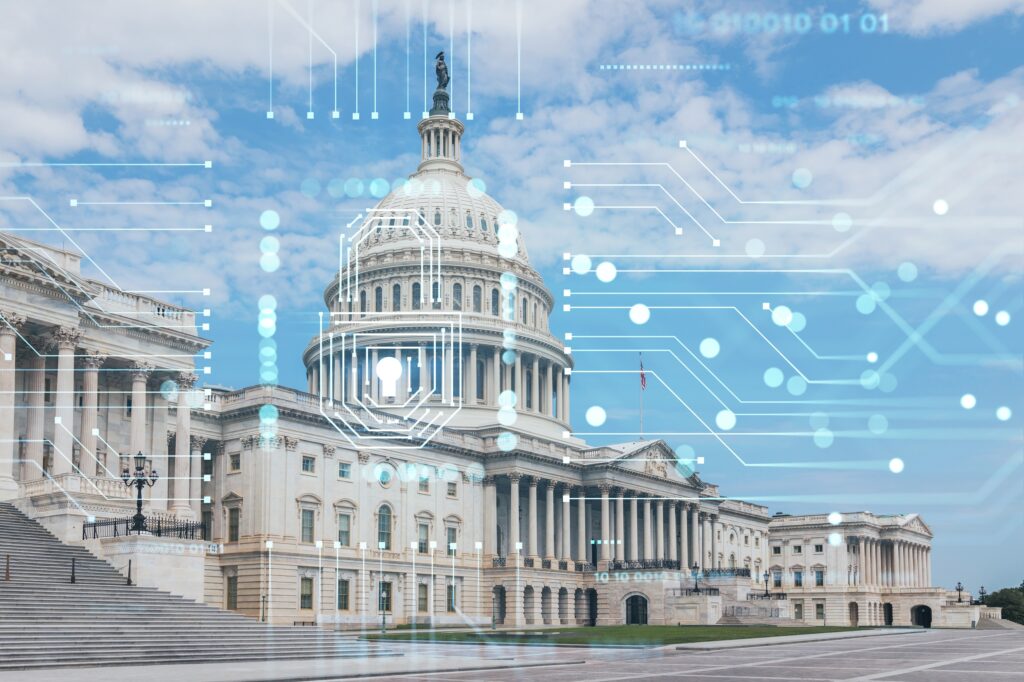Congress’s Tech Policy Knowledge Gap
“Suppose you were an idiot,” Mark Twain once quipped, “and suppose you were a member of Congress; but I repeat myself.” Like Twain, libertarians tend not to think highly of elected officials. We view them as corrupt, in cahoots with interest groups, and obsessed with politicking instead of governing.
And, as Twain quipped, dumb. Oh, so, dumb. Who can forget Rep. Hank Johnson (D-Ga.) fretting aloud that an island might tip over if too many soldiers are stationed on one side of it? And how about Rep. Louie Gohmert (R-Texas), who freaked people out by claiming al Qaeda had camps near the U.S.-Mexico border? Does a week go by without one of the 535 members of our national legislature popping off inanely? Probably not.
Indeed, as Twain’s quote indicated, Congress never has been filled with Solons, to say nothing of Erasmuses. Even our much revered Founders made some seriously wrongheaded decisions. (See the Alien and Sedition Acts of 1798, to cite only one example among many.)
But stupidity in our national legislature is a feature of representative democracy. Americans want to choose their leaders; they do not wish to have unaccountable mandarins imposing rulership. (Hence our current battle against the administrative state.) Congress lacks wisdom, in short, because Congress is us. After all, we are not a nation comprised wholly or even mostly of expert policymakers. We are store clerks, construction workers, and telemarketers, and the national legislature is simply the place where our partial views and diverse interests get bargained out into policy that hopefully we all can live with. (James Madison’s Federalist 10 is about as clear-eyed and unsentimental an account of this truth as can be found.)
But this “feature” of representative democracy is also a bug because, as it turns out, when non-expert policymakers craft policy, they often do it poorly. For example, no one wants Congress enacting policies that make us worse off, or that delay or stifle technologies that improve our lives. And yet this kind of bad policy happens with lamentable frequency. Pluralistic politics inevitably features some self-serving interests that are more powerful and politically persuasive than others. This is why government often undertakes bailouts and other actions that are odious to the public writ large.
And this brings us to science and technology policy. In recent years, Congress’s ineptitude in these areas has been richly displayed. Late last year, for example, Rep. Mark Green (R-Tenn.) drew brickbats when he suggested autism is associated with vaccines. Congressional elders on the dais trying to understand 21st-century technology are often so absurd that they have become a meme. Senate Minority Leader Chuck Schumer (D-N.Y.) uses a flip phone, while his colleague Lindsey Graham (R-S.C.) eschews email. As Washington Monthly’s Grace Gedye recently put it,
These old-fashioned habits may be charming coming from your grandparents, but your grandparents aren’t charged with legislating on cryptocurrency, regulating autonomous vehicles, or protecting consumers from data breaches. Members’ technical naïveté goes beyond their choice in phones and onto the floor of Congress. When experts testified before Congress last May about the promise of quantum computing—which could radically accelerate research into everything from pharmaceuticals to machine learning to carbon sequestration—Illinois Representative Adam Kinzinger (R-IL) admitted, half-jokingly, to the panel, ‘I can understand about 50 percent of the things you say.’
Such inadequate expertise in science and technology is bipartisan, and longstanding. Not quite 50 years ago, Congress took a significant step to bolster its brains when it created the Office of Technology Assessment (OTA) in 1972, after spending a decade considering and debating its struggles to govern in the space age. As the agency’s name implies, OTA’s basic function was “to provide early indications of the probable beneficial and adverse impacts of the applications of technology and to develop other coordinate information which may assist the Congress.” (2 U.S.C. § 472)
The OTA’s bread and butter were its lengthy assessment reports, which included shorter-form executive summaries and that reviewed the existing research and data on a topic (e.g., “Costs and Effectiveness of Cholesterol Screening in the Elderly”), and then explained what the evidence demonstrated or did not. And since its statutory mandate was narrow (merely to study emergent technologies and advise Congress about their potential impact), the OTA’s’s nerds advised on the pros and cons of different policy approaches, but did not tell the legislature which policies to support in the way that think tanks do.
Moreover, because Congress did not want the OTA to be an agenda-setter that drove the legislature’s work, the agency was not authorized to research any topic it pleased. The law specified that it could initiate studies only at the request of a committee (originating either from its chairman, ranking minority member, or a simple majority), or from OTA’s board or its director. For the sake of partisan balance, the director was appointed by the 12-person board, whose members were six senators (half Democrats and half Republicans) and six representatives (also equally divided by party). The OTA was also overseen by an advisory panel, which was appointed by Congress. Members included the heads of the Government Accountability Office and the Congressional Research Service and ten members of the public. Its job was to assess the agency’s work and recommend improvements. (2 U.S.C. § 476)
Structurally, the OTA was ahead of its time. It was a Wiki-like bureaucracy that relied heavily on the private sector. It had a modest cohort of experts in-house, but heavily leveraged outside expertise to produce its assessments. For example, the agency’s 1990 report on “Affordable Spacecraft: Design and Launch Alternatives” was based upon discussions and research supplied by a bevy of researchers, including those at George Mason University, Rockwell International, and NASA.
It also bears noting that the OTA was not an idiosyncrasy. At the time, the agency was merely the latest addition to Congress’s corps of in-house experts. It had already established the Library of Congress in 1800, the Congressional Research Service (CRS) in 1914, and the Government Accountability Office (GAO) in 1921. Two years after launching the OTA, Congress established the Congressional Budget Office (CBO). All of these efforts aimed to augment the limited expertise of legislators and Capitol Hill staff with the input of nonpartisan experts with long tenures and no stakes in the outcomes of any particular policy vote.
Unfortunately—as readers may likely recall—the OTA was abolished in 1995—right on the cusp of the Internet Age. Congress simply cut off the agency’s funds, and its 120 employees packed up their desks and exited the building. It was a bizarre decision that reflected convoluted legislative logic. A few years earlier, wracked with various scandals, Congress had decided to clean house. To show the public it was serious, it proposed cutting its own budget. As a result, it reduced committee staff, slashed 25 percent of the GAO’s workforce, and zeroed out the OTA.
Perversely, all of this made Congress weaker vis-à-vis the president and the administrative state. The executive branch has an army of science and technology wonks who are more than happy to issue regulations and regulatory dark matter—all of whom are free from electoral consequences. Fewer nonpartisan experts on Capitol Hill also has strengthened the hand of lobbyists and interest groups, who use their own expertise to shape policy. Over the years, various lone voices have called for a revival of the OTA. Former Rep. Rush Holt (D-N.J.), himself a scientist, regularly introduced legislation to fund the agency. In recent years, Rep. Bill Foster (D-Ill.), a physicist, has carried the torch, along with Rep. Mark Takano (D-Calif.).
Their efforts inevitably ran into anxieties about the political optics of Congress spending money on itself, and the persistent question raised by the story of Cincinnatus: “Who needs expertise?” After all, any citizen should be able to come into the assembly and use good horse sense to decide policy.
The story of Cincinnatus is a myth, however. In fact, he was no simple farmer. As Thomas Ranieri points out: “Cincinnatus, as a senator and patrician, was a member of the political ruling class. He spent his youth working his way through the cursus honorum, which is the series of offices (both civil and military) designed to prepare senators for the rank of consul and give them the experience needed to wield imperium, the Roman Republic’s official grant of power.”
More recently, the 21st century’s incredible, and often unsettling, technological developments along with Congress’s high profile gaffes in responding to them have helped reinvigorate interest in strengthening Congress’s capacity. Accordingly, in spring 2018, it took steps to restore its brain power and directed the GAO to increase the number of its staff working on science and technology studies. The statute also directed the National Academy of Public Administration to study Congress’s technological and scientific capacity and propose remedies, which might include reviving the OTA. (The study will be completed this autumn.)
This spring, Congress proposed appropriating $6 million to restart the OTA. Whether this will be enacted remains to be seen. However, even if it does happen, at most, that amount of funding will enable the agency to turn the lights on and to hire a few dozen staff. This leaves unanswered the larger question: what should be done about Congress’s ineptitude in technology and science issues?
Those of us who favor small government and fiscal responsibility often are inclined to seize upon an elegant solution: get government out of science and technology issues. Voilà! The problem of stupid governance is solved!
If only it were so simple. But, in fact, our national government has been involved in scientific and technological issues since it began. Government itself often funds the research that sparks new technological developments (like rocketry and nuclear energy) and it is also a major consumer of new technologies, some of which raise concerns among the liberty-minded (like facial recognition software).
Moreover, new technology almost inevitably sparks some sort of government response—frequently at the behest of voters. The earliest Congresses invested in lighthouses, (which benefited coastal states), and later directed the postal service to carry mail via paddlewheel and steam-engine boats (which boat operators loved). Today, government feels obligated to respond to citizens who are anxious about social media vacuuming up personal data, drones hovering over backyards, and encryption being deployed to traffic child pornography.
So if government is going to be involved, our choice is to leave it to the unaccountable executive branch and hope for the best, or to have Congress—whose ears we can bend and whom we can boot from office—get smarter. Of course, making all—or even most—legislators wise about science and technology is impossible. Elected officials have neither inclination nor time to crack studies on gene editing or 4G. (One study suggests legislators spend only a third of their work hours fundraising for re-election. The rest goes to other tasks, such as campaigning and responding to constituent demands.)
For this reason, think tanks, like my own, try to help Congress tackle complex issues by sharing our expertise. But far too few of us exist to fill that role, and think tanks are not designed to be help desks for Congress. Rather, they do work that donors want to fund, which often is not what Congress may want to know at any particular point in time.
Certainly, hiring more nonpartisan nerds to help Congress does not feel like a very small-government thing to do. Thankfully, the sums of money involved are minute—in the tens of millions of dollars, which literally is a rounding error in the $4+ trillion budget. (Nearly all of which, notably, runs through the executive branch.)
A libertarian might also worry about these geeks becoming unelected rulers, which is exactly what they would be if they worked for the executive branch. Housing them within the legislative branch reduces that peril because it disables the nerds from actually enacting policy. People who work for a revived OTA, or the current GAO, cannot cast votes in Congress. Their role is an age-old one that well comports with our governance system. As Professor Tom Nichols has written: “The United States is a republic, in which the people designate others to make [governance] decisions on their behalf. Those elected representatives cannot master every issue […] Experts advise. Elected leaders decide.”
It is not clear whether the Congress of today needs the OTA of the past or a modification thereof. The old OTA spent most of its energy producing long studies that tried to grasp what changes new technologies might bring. The rest of its time was spent offering consultations to legislators with questions on particular scientific and technological issues.
The current Congress might benefit from an OTA that spends more time on the latter than the former. One can imagine a new OTA that is even more of a Wiki. The agency would keep a modest corps of scientists and technologists, but would network these staff to experts around the nation and world. Thus, when Congress was confronted with a breaking issue (like an intelligence agency claiming a rogue nation is weaponizing a new biotoxin), the OTA could activate its network of experts and provide legislators with research materials and briefings.
Scientific and technological innovations will continue apace. Assuredly, Congress cannot be expected to get any smarter on its own. So the choice seems obvious. By hook or crook, we should “bring in the nerds.”







